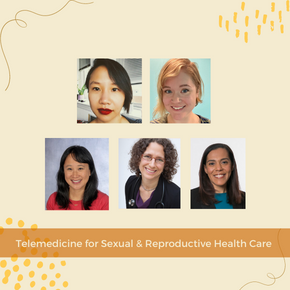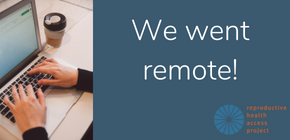Aug 14

Help Us Protect Access to Sexual and Reproductive Health Care Today!
About 1 in 5 women* will experience early pregnancy loss, also known as miscarriage, and often in the first 12 weeks. Pregnant and birthing people face enormous and unacceptable stigma and shame when they experience a pregnancy loss, and are often not encouraged to talk about their loss. This stigma silences people’s voices, leads to isolation and disconnection, and perpetuates a cycle of shame surrounding pregnancy loss.
At RHAP, we believe that every person and family facing an early pregnancy loss should have the facts about what is happening to their bodies, what their options are, and how common an experience this actually is. This is why we developed a zine called Anita’s Miscarriage: A Story of Early Pregnancy Loss, by artist Karina Shor, that follows a couple’s experience with an early pregnancy loss. We created this evidence-based resource to illustrate how talking about an EPL can help break the cycle of silence and shame and support families in beginning to heal from their grief. The zine also talks about the types of EPL management options that can be offered in respectful, dignified, and evidence-based ways, depending on your preferences and needs: expectant management (“watch and wait”), medication management (with mifepristone + misoprostol, or misoprostol alone), and uterine aspiration (outpatient procedure).
Everyone deserves the opportunity to manage their early pregnancy loss in a way that’s best for them. Too often, early pregnancy loss is treated in the ER, when in reality, your primary care clinician can provide you the care and support that you need. This is why we’re committed to improving access to all forms of care within primary care settings through our Miscarriage Care Initiative, research efforts, and patient education resources.
October 15th is Pregnancy and Infant Loss Awareness Day. Join us in working to create a safe, supportive space to elevate people’s stories and experiences and to support clinicians in providing this essential care.
*We recognize that women are not the only people who can have pregnancy experiences. When we refer to women, we are referring to data in studies that only look at cis-gender females and people who identify as women.

We know that the past year has been brutal for access to abortion care, with legislative attacks at the state level reaching historic highs. However, there have been some crucial wins in the fight to protect access! Here are a few:
On Wednesday, October 6th, a federal judge in West Texas issued a temporary injunction on the enforcement of SB 8, an unconstitutional six-week ban that also allows anyone—including anti-abortion vigilantes—to enforce the ban by suing abortion providers and anyone who helps a person obtain an abortion after six weeks of pregnancy. This ruling is a result of a lawsuit against Texas from the Department of Justice. The DOJ noted that it is unprecedented for a state government to allow private individuals to infringe on individuals’ rights, and that this law is a direct violation of Supreme Court precedent.
For 36 days, SB 8 denied millions of Texans their constitutional right to abortion, causing untold harm to Texans seeking abortion care – particularly for communities that already experience significant barriers to accessing care. While this injunction remains in place, no lawsuits under SB 8 may be filed or accepted.
Unfortunately, this injunction is just temporary- and the State of Texas has already filed an appeal to the Fifth Circuit. And even with SB 8 blocked, Texans still face often insurmountable barriers to care due to medically unnecessary restrictions such as bans on abortion coverage, waiting periods, parental notification, and more. This is why we need our elected officials at the federal level to step in and protect access to abortion care for everyone in the United States.
On September 24, the U.S. House of Representatives passed the Women’s Health Protection Act (WHPA) in a historic win for reproductive health, rights, and justice advocates. WHPA creates a statutory right for health care providers to provide abortion care, and an equal right for patients to receive abortion care, without restrictions or bans. Now, WHPA goes to the Senate, where Senate Majority Leader Chuck Schumer has promised to bring it to the floor for a vote. Tell your Senators to pass the WHPA now!
Finally, last week, the U.S. Department of Health and Human Services (HHS) released its final Title X rule, which overturns a Trump-era rule that denied Title X funding (federal family planning grants) to health care centers that offered unbiased options counseling, including abortion referrals. As a result, over 1,300 health centers will now be able to receive Title X funding once more. This goes into effect on November 8, 2021. Thank you to all of the leaders and advocates who spearheaded efforts to overturn this rule, including RHAP supporters who helped submit comments to HHS!

Telehealth–providing health care services and health education remotely through digital and communication technologies–has been thrusted into the mainstream during the COVID-19 pandemic. Nearly all primary care clinicians in the US (97%) were using some form of telemedicine with patients by April 2020 (2) and telemedicine now accounts for 15 to 20% of health care delivery. (3) On Thursday, September 23, during Teleheath Awareness Week, RHAP hosted a panel exploring the benefits, drawbacks, and equity implication of telemedicine for sexual and reproductive health care. We were pleased to welcome Network members Liz Kaltman, ND, MPH, NCMP, Tina Wheat, MD, MPH, Angeline Ti, MD, MPH, Lin-Fan Wang, MD, and Kaity Stewart, CNM, PMHNP-BC, SANE-A as guest speakers. Throughout the evening, panelists covered a range of topics, including contraceptive care, early pregnancy loss care, abortion care, gender-affirming care, and prenatal care.
Panelists highlighted patient agency and accessibility as key benefits of telemedicine. Patients can have more power in telehealth and can push back against the clinical gatekeeping of health care persistent in the in-patient setting. For example, rejecting the patronizing and harmful practice of requiring an in-person visit for a pap smear before refilling a birth control prescription. Unlike in-person office visits, patients do not have to worry about showing their ID, being misgendered, interacting with police, or securing transportation. Additionally, patients can decide where they are for their telehealth appointment and they can have a number of support people accompany them to their visit if they choose (family members, a therapist, doula, or a friend.) Panelists also highlighted that telemedicine enables clinicians to spend more time with patients – uninterrupted by clinic constraints. Longer appointments have allowed providers to support patients who wanted guidance on IUD self-removal or space to process and grieve an early pregnancy loss.
Telemedicine’s potential to close gaps in health care is expansive. However, there are several access barriers that need to be addressed as this field continues to grow throughout the COVID-19 pandemic and beyond. Limited tech literacy and poor broadband access disproportionately affect elders, houseless people, and folks in rural communities. Additionally, the COVID-19 pandemic has placed many brick and mortar clinics in survival mode with limited resources to invest in telemedicine infrastructure. State laws can also create access obstacles. Currently, nineteen states prohibit telemedicine for abortion care (4) and the complex web of laws governing licensing and prescribing across state lines are difficult for providers to navigate (5). As the geographic area of telehealth expands, guest speakers also emphasize the importance of building out local networks so if telehealth patients far away need an in-person follow up, clinicians are able to refer them to a local clinician who is supportive and practices patient-centered, evidence-based health care.
Our September panel underscored the critical role telemedicine will continue to play in primary care and the fight for health equity. Click here to check out RHAP’s telemedicine resources for clinicians and health care providers. To learn more about telemedicine policy initiatives at the state and national level visit the American Telemedicine Association.

Almost four years ago, RHAP finally moved into our very first standalone office. This was big for us – we had been working out of a space in a community health center in New York City since our inception, but we had officially outgrown it!
Our move was a big deal – we had our own space, great light, and room for a larger team. It really felt like our space. But, like many people, when the pandemic reached New York City in early March 2020, we went from working at the office every day to full-time working from home. Our office looked as if it was frozen in time, as if we had all just gone out to lunch. The transition to remote work was an adjustment – we had to develop new systems and find new ways to stay connected as a team – but we found that it worked for us.
As our return-to-the-office plans kept shifting further back, we started to talk about it as an “if” instead of a “when.” Did we all need to work out of the same location every day? Did we have to be physically together to work successfully as a team? The answer was no. Our staff liked the flexibility that working remotely provided and having no office also gave us another strength – a national team. We could hire people in different parts of the country. We were already working across time zones with clinicians in other areas, so why not bring on a more geographically-diverse staff as well?
In January 2021, our first non-New York employee started in Massachusetts. In May, another one joined from California. We hired summer interns from Texas, Oregon, and Maryland. In September, our newest employee started in Georgia. Having folks from different parts of the country join us gave us even more insight into the local reproductive health realities across the country.
On August 31, 2021, we officially closed our in-person office. While we will always have fond memories of our very first office, we’re now a 100% remote organization that is truly national – and we’re loving it.
Your gift allows us to train and support health care providers across the United States so they can offer patients compassionate and comprehensive care.
Aug 14
